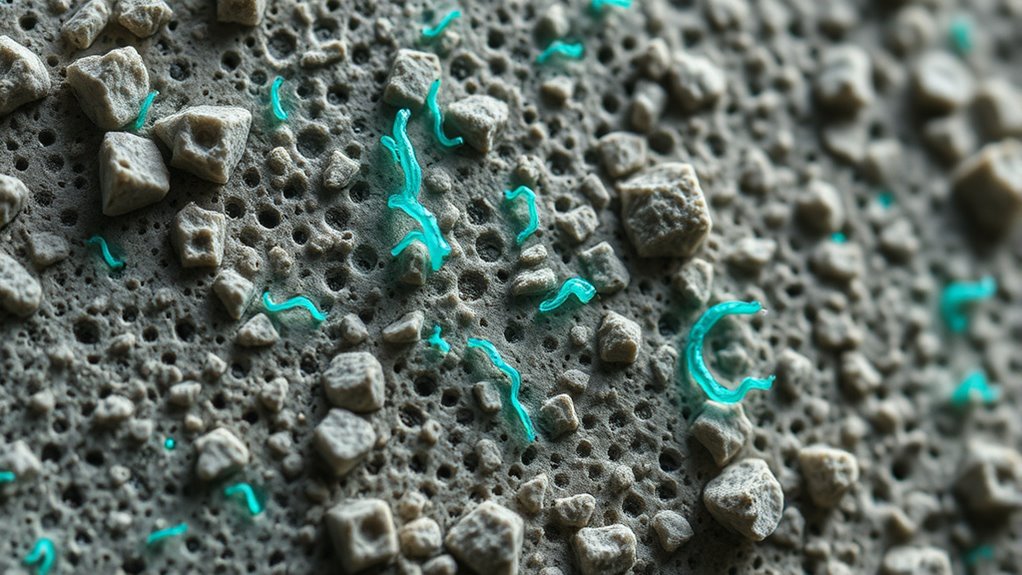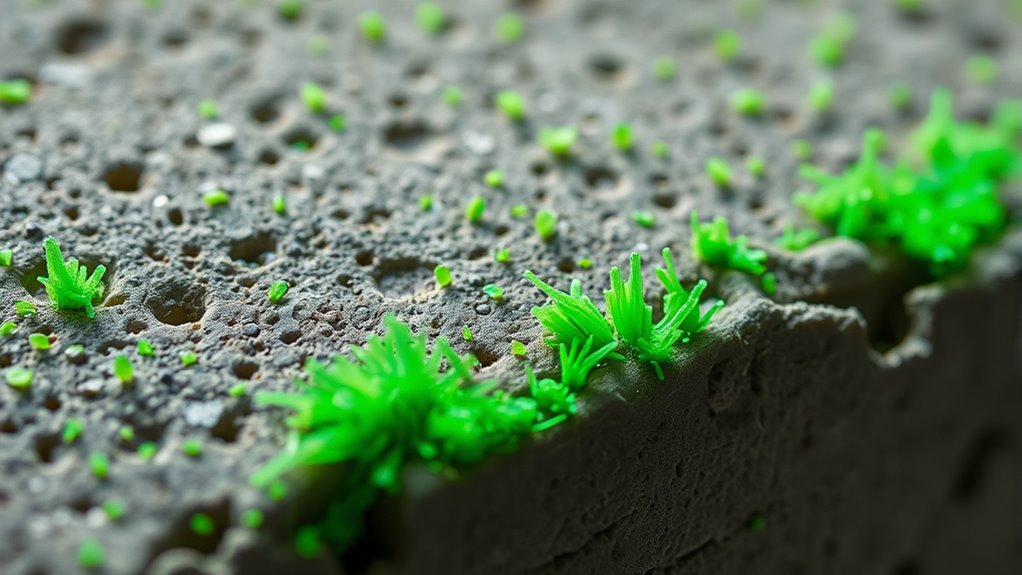Bio-cement uses bacteria to create sustainable, carbon-neutral concrete by naturally producing limestone that binds materials together. This process relies on biological activity, consumes less energy, and reduces harmful emissions compared to traditional cement. It’s versatile for repairs or large projects, lowering environmental impact and conserving resources. By harnessing bacteria’s natural ability, bio-cement offers an eco-friendly alternative that can transform construction. To explore how this innovative method works and its potential benefits, keep discovering more about its fascinating process.
Key Takeaways
- Bio-cement uses bacteria to produce limestone, creating a carbon-neutral alternative to traditional concrete.
- Bacteria metabolize water and nutrients to bind materials, reducing energy consumption and emissions during production.
- The process promotes sustainable construction by minimizing environmental impact and conserving natural resources.
- Bio-cement can be scaled for various applications, from small repairs to large infrastructure projects.
- It enhances durability and self-healing of structures, lowering maintenance costs and extending lifespan.

Have you ever wondered how scientists are transforming the construction industry with eco-friendly materials? One exciting innovation is bio-cement, a form of concrete created through the activity of bacteria. Unlike traditional cement, which contributes markedly to carbon emissions during production, bio-cement offers a sustainable alternative that could drastically reduce environmental impact.
This breakthrough harnesses natural biological processes to produce a material with the same strength and durability as conventional concrete but with a much lower carbon footprint. The process involves introducing specific bacteria into a mixture of water, sand, and other aggregates. These bacteria produce limestone as a metabolic byproduct, effectively binding the materials together. Because this process relies on biological activity, it consumes far less energy and emits fewer greenhouse gases, making it a promising solution for eco-conscious construction projects.
In terms of industrial applications, bio-cement is gaining attention for its versatility and potential to revolutionize how we build. It can be used for everything from small-scale repairs to large infrastructure projects. For example, bio-cement can be employed to create more sustainable building blocks, reduce the environmental impact of concrete production, or even repair damaged structures without the need for extensive demolition or new materials. Additionally, biological processes involved make the production process more adaptable to different environmental conditions, increasing its practical utility.
Its ability to self-heal cracks when bacteria produce additional limestone helps extend the lifespan of structures, decreasing maintenance costs and waste. Industries focused on environmentally friendly construction are particularly interested in bio-cement because it aligns with global efforts to reduce carbon emissions and promote sustainable development.
The environmental impact of bio-cement extends beyond just lowering carbon emissions; it also reduces the reliance on quarrying and mining for raw materials, which often cause habitat destruction and pollution. Since bacteria can produce cement-like material using minimal resources, bio-cement minimizes waste and conserves natural resources.
Additionally, because the bacteria can be cultivated easily and grown in controlled environments, this process offers a scalable and adaptable solution for various industrial needs. As more companies and governments recognize the importance of reducing their carbon footprint, bio-cement’s role in sustainable construction is expected to expand rapidly.
Furthermore, advancements in Linguistic Features and Figurative Language are enhancing how we communicate the benefits of bio-cement, making complex scientific concepts more accessible and engaging for diverse audiences.
Frequently Asked Questions
How Long Does Bio-Cement Take to Fully Harden?
You’re wondering how long it takes for bio-cement to fully harden. Typically, the curing time depends on factors like environmental conditions and microbial curing processes.
Usually, bio-cement reaches its full strength within a week or two, but it can vary. During this period, microbial curing helps the bacteria produce minerals that strengthen the concrete.
Patience is key, as proper curing ensures the bio-cement achieves maximum durability and structural integrity.
Can Bio-Cement Repair Itself After Damage?
You might wonder if bio-cement can repair itself after damage. The good news is, it has self-healing properties that help maintain its structural integrity.
When cracks form, bacteria within the bio-cement can produce new mineral deposits to fill and repair those damages. This process helps preserve the material’s strength and durability, making bio-cement a sustainable and long-lasting option for construction.
What Are the Costs Compared to Traditional Concrete?
You might wonder about the cost comparison between bio-cement and traditional concrete. Currently, bio-cement tends to be more expensive due to specialized bacteria and production processes.
However, its potential for self-healing and environmental benefits could improve economic feasibility over time. Although initial costs are higher, long-term savings on repairs and sustainability might make bio-cement a worthwhile investment, especially as technology advances and scales up.
Are There Any Environmental Risks With Bacteria Use?
You might wonder about environmental impact and microbial safety when using bacteria in construction. While bacteria can be environmentally friendly, there are risks if the microbes aren’t properly controlled, potentially affecting local ecosystems or human health.
However, with strict safety protocols and careful management, these risks are minimized. Overall, using bacteria responsibly can lead to sustainable construction without significant environmental dangers.
How Scalable Is Bio-Cement for Large Construction Projects?
You wonder how scalable bio-cement is for large projects. While it shows promise, scaling challenges like maintaining consistent bacterial activity and ensuring a reliable supply chain can be hurdles.
You’ll need to develop efficient production methods and logistics to meet high demand. With ongoing research and technological advancements, you can expect these issues to diminish over time, making bio-cement a feasible, sustainable option for big construction endeavors.
Conclusion
You might think bio-cement isn’t strong enough for real construction, but it actually offers durable, eco-friendly solutions. Its natural process reduces carbon emissions markedly compared to traditional concrete, making it a smarter choice for sustainable building. By supporting bio-cement, you’re helping combat climate change without sacrificing strength or safety. So, don’t let doubts hold you back—embrace this innovative, environmentally friendly alternative that’s ready to revolutionize the construction industry.








